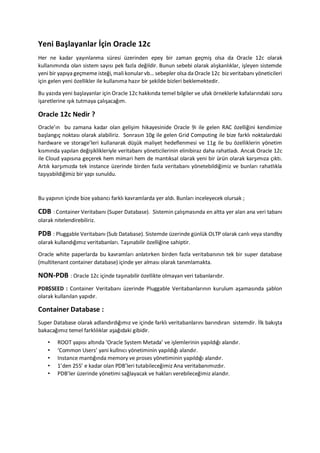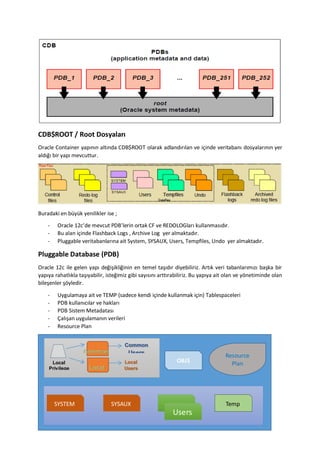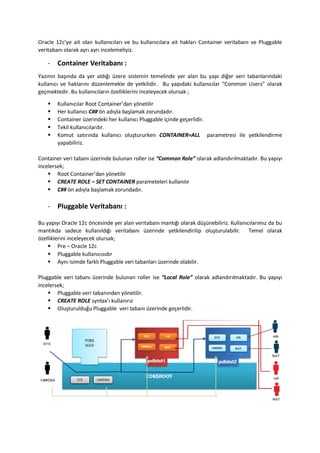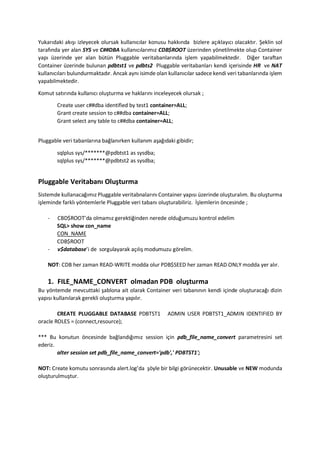Yeni ba?layanlar i??in Oracle 12c
- 1. Yeni Ba?layanlar ??in Oracle 12c Her ne kadar yay?nlanma s®πresi ®πzerinden epey bir zaman ge?mi? olsa da Oracle 12c olarak kullan?m?nda olan sistem say?s? pek fazla de?ildir. Bunun sebebi olarak al??kanl?klar, i?leyen sistemde yeni bir yap?ya ge?meme iste?i, mali konular vb°≠ sebepler olsa da Oracle12c biz veritaban? y?neticileri i?in gelen yeni ?zellikler ile kullan?ma haz?r bir ?ekilde bizleri beklemektedir. Bu yaz?da yeni ba?layanlar i?in Oracle 12c hakk?nda temel bilgiler ve ufak ?rneklerle kafalar?ndaki soru i?aretlerine ???k tutmaya ?al??aca??m. Oracle 12c Nedir ? Oracle°Ø?n bu zamana kadar olan geli?im hikayesinide Oracle 9i ile gelen RAC ?zelli?ini kendimize ba?lang?? noktas? olarak alabiliriz. Sonras?n 10g ile gelen Grid Computing ile bize farkl? noktalardaki hardware ve storage°Øleri kullanarak d®π?®πk maliyet hedeflenmesi ve 11g ile bu ?zelliklerin y?netim k?sm?nda yap?lan de?i?iklikleriyle veritaban? y?neticilerinin elinibiraz daha rahatlad?. Ancak Oracle 12c ile Cloud yap?s?na ge?erek hem mimari hem de mant?ksal olarak yeni bir ®πr®πn olarak kar??m?za ??kt?. Art?k kar??m?zda tek instance ®πzerinde birden fazla veritaban? y?netebildi?imiz ve bunlar? rahatl?kla ta??yabildi?imiz bir yap? sunuldu. Bu yap?n?n i?inde bize yabanc? farkl? kavramlarda yer ald?. Bunlar? inceleyecek olursak ; CDB : Container Veritaban? (Super Database). Sistemin ?al??mas?nda en altta yer alan ana veri taban? olarak nitelendirebiliriz. PDB : Pluggable Veritaban? (Sub Database). Sistemde ®πzerinde g®πnl®πk OLTP olarak canl? veya standby olarak kulland???m?z veritabanlar?. Ta??nabilir ?zelli?ine sahiptir. Oracle white paperlarda bu kavramlar? anlat?rken birden fazla veritaban?n?n tek bir super database (multitenant container database) i?inde yer almas? olarak tan?mlamakta. NON-PDB : Oracle 12c i?inde ta??nabilir ?zellikte olmayan veri tabanlar?d?r. PDB$SEED : Container Veritaban? ®πzerinde Pluggable Veritabanlar?n?n kurulum a?amas?nda ?ablon olarak kullan?lan yap?d?r. Container Database : Super Database olarak adland?rd???m?z ve i?inde farkl? veritabanlar?n? bar?nd?ran sistemdir. ?lk bak??ta bakaca??m?z temel farkl?l?klar a?a??daki gibidir. ? ROOT yap?s? alt?nda °ÆOracle System Metada°Ø ve i?lemlerinin yap?ld??? aland?r. ? °ÆCommon Users°Ø yani kulln?c? y?netiminin yap?ld??? aland?r. ? Instance mant???nda memory ve proses y?netiminin yap?ld??? aland?r. ? 1°Øden 255°Ø e kadar olan PDB°Øleri tutabilece?imiz Ana veritaban?m?zd?r. ? PDB°Øler ®πzerinde y?netimi sa?layacak ve haklar? verebilece?imiz aland?r.
- 2. CDB$ROOT / Root Dosyalar? Oracle Container yap?n?n alt?nda CDB$ROOT olarak adland?r?lan ve i?inde veritaban? dosyalar?n?n yer ald??? bir yap? mevcuttur. Buradaki en b®πy®πk yenilikler ise ; - Oracle 12c°Øde mevcut PDB°Ølerin ortak CF ve REDOLOGlar? kullanmas?d?r. - Bu alan i?inde Flashback Logs , Archive Log yer almaktad?r. - Pluggable veritabanlar?na ait System, SYSAUX, Users, Tempfiles, Undo yer almaktad?r. Pluggable Database (PDB) Oracle 12c ile gelen yap? de?i?ikli?inin en temel ta??d?r diyebiliriz. Art?k veri tabanlar?m?z? ba?ka bir yap?ya rahatl?kla ta??yabilir, iste?imiz gibi say?s?n? artt?rabiliriz. Bu yap?ya ait olan ve y?netiminde olan bile?enler ??yledir. - Uygulamaya ait ve TEMP (sadece kendi i?inde kullanmak i?in) Tablespaceleri - PDB kullan?c?lar ve haklar? - PDB Sistem Metadatas? - ?al??an uygulaman?n verileri - Resource Plan Kullan?c?lar ve Roller SYSTEM SYSAUX Users Temp OBJ$ Resource PlanLocal Privilege Common Local Common Users Local Users
- 3. Oracle 12c°Øye ait olan kullan?c?lar? ve bu kullan?c?lara ait haklar? Container veritaban? ve Pluggable veritaban? olarak ayr? ayr? incelemeliyiz. - Container Veritaban? : Yaz?n?n ba??nda da yer ald??? ®πzere sistemin temelinde yer alan bu yap? di?er veri tabanlar?ndaki kullan?c? ve haklar?n? d®πzenlemekle de yetkilidir. Bu yap?daki kullan?c?lar °∞Common Users°± olarak ge?mektedir. Bu kullan?c?lar?n ?zelliklerini inceleyecek olursak ; ? Kullan?c?lar Root Container°Ødan y?netilir ? Her kullan?c? C## ?n ad?yla ba?lamak zorundad?r. ? Container ®πzerindeki her kullan?c? Pluggable i?inde ge?erlidir. ? Tekil kullan?c?lard?r. ? Komut sat?r?nda kullan?c? olu?tururken CONTAINER=ALL parametresi ile yetkilendirme yapabiliriz. Container veri taban? ®πzerinde bulunan roller ise °∞Common Role°± olarak adland?r?lmaktad?r. Bu yap?y? incelersek; ? Root Container°Ødan y?netilir ? CREATE ROLE ®C SET CONTAINER parameteleri kullan?l?r ? C## ?n ad?yla ba?lamak zorundad?r. - Pluggable Veritaban? : Bu yap?y? Oracle 12c ?ncesinde yer alan veritaban? mant??? olarak d®π?®πnebiliriz. Kullan?c?lar?m?z da bu mant?kda sadece kullan?ld??? veritaban? ®πzerinde yetkilendirilip olu?turulabilir. Temel olarak ?zelliklerini inceleyecek olursak; ? Pre ®C Oracle 12c ? Pluggable kullan?c?s?d?r ? Ayn? isimde farkl? Pluggable veri tabanlar? ®πzerinde olabilir. Pluggable veri taban? ®πzerinde bulunan roller ise °∞Local Role°± olarak adland?r?lmaktad?r. Bu yap?y? incelersek; ? Pluggable veri taban?ndan y?netilir. ? CREATE ROLE syntax°Ø? kullan?r?z ? Olu?turuldu?u Pluggable veri taban? ®πzerinde ge?erlidir.
- 4. Yukar?daki ak??? izleyecek olursak kullan?c?lar konusu hakk?nda bizlere a??klay?c? olacakt?r. ?eklin sol taraf?nda yer alan SYS ve C##DBA kullan?c?lar?m?z CDB$ROOT ®πzerinden y?netilmekte olup Container yap? ®πzerinde yer alan b®πt®πn Pluggable veritabanlar?nda i?lem yapabilmektedir. Di?er taraftan Container ®πzerinde bulunan pdbtst1 ve pdbts2 Pluggable veritabanlar? kendi i?erisinde HR ve NAT kullan?c?lar? bulundurmaktad?r. Ancak ayn? isimde olan kullan?c?lar sadece kendi veri tabanlar?nda i?lem yapabilmektedir. Komut sat?r?nda kullan?c? olu?turma ve haklar?n? inceleyecek olursak ; Create user c##dba identified by test1 container=ALL; Grant create session to c##dba container=ALL; Grant select any table to c##dba container=ALL; Pluggable veri tabanlar?na ba?lan?rken kullan?m a?a??daki gibidir; sqlplus sys/**@pdbtst1 as sysdba; sqlplus sys/**@pdbtst2 as sysdba; Pluggable Veritaban? Olu?turma Sistemde kullanaca??m?z Pluggable veritabnalar?n? Container yap?s? ®πzerinde olu?tural?m. Bu olu?turma i?leminde farkl? y?ntemlerle Pluggable veri taban? olu?turabiliriz. ??lemlerin ?ncesinde ; - CBD$ROOT°Øda olmam?z gerekti?inden nerede oldu?umuzu kontrol edelim SQL> show con_name CON_NAME CDB$ROOT - v$database°Øi de sorgulayarak a??l?? modumuzu g?relim. NOT: CDB her zaman READ-WRITE modda olur PDB$SEED her zaman READ ONLY modda yer al?r. 1. FILE_NAME_CONVERT olmadan PDB olu?turma Bu y?ntemde mevcuttaki ?ablona ait olarak Container veri taban?n?n kendi i?inde olu?turaca?? dizin yap?s? kullan?larak gerekli olu?turma yap?l?r. CREATE PLUGGABLE DATABASE PDBTST1 ADMIN USER PDBTST1_ADMIN IDENTIFIED BY oracle ROLES = (connect,resource); *** Bu konutun ?ncesinde ba?land???m?z session i?in pdb_file_name_convert parametresini set ederiz. alter session set pdb_file_name_convert='pdb',' PDBTST1'; NOT: Create komutu sonras?nda alert.log°Øda ??yle bir bilgi g?r®πnecektir. Unusable ve NEW modunda olu?turulmu?tur.
- 5. 2. FILE_NAME_CONVERT ile PDB olu?turma Olu?turaca??m?z veritaban?n? FILE_NAME_CONVERT parametresini kullanarak kendi belirleyece?imiz dizin i?inde olu?turma imkan? sa?layacakt?r. CREATE PLUGGABLE DATABASE PDBTST1 ADMIN USER PDBTST1_ADMIN IDENTIFIED BY oracle FILE_NAME_CONVERT = ('/disk2/app/oracle/oradata/orcl/pdbseed','/disk2/dbf'); Son olarak Container veri taban? ®πzerinde bulunan Pluggable veri tabanlar?n?n durumuna bakal?m. SQL> SELECT name,open_mode FROM v$pdbs; NAME OPEN_MODE PDB$SEED READ ONLY PDBTST1 NEW Veritaban? A??l?? ®C Kapan?? Modlar? Oracle 12c ile veri tabanlar?n?n y?netimsel olarak farkl?l?klar?ndan da bir tanesi de veri taban? a?ma kapama i?lemlerindedir. Temel olarak Container veri taban?nda di?er Pluggable veri tabanlar?na ait a?ma kapama i?lemlerini de yapabiliriz. Bu modlar? inceleyecek olursak ; - Veri Taban? A?ma ??lemleri Container Veri taban? ®πzerinde a?a??daki komutlarla bir veya birden fazla veri taban?n? a?abiliriz. ALTER PLUGGABLE DATABASE pdbtst1 OPEN; ALTER PLUGGABLE DATABASE ALL OPEN; A??lan veri tabanlar?n?n kontrol®π i?in ; SQL> SELECT name,open_mode FROM v$pdbs; NAME OPEN_MODE PDB$SEED READ ONLY PDBORCL READ WRITE PDBTST1 READ WRITE
- 6. Container veri taban?n? a?mak istedi?imizde ise normal bir veri taban?nda yapt???m?z komutlar yeterli olacakt?r; SQL> ALTER DATABASE OPEN; SQL> STARTUP - MOUNT ®C SHUTDOWN ??lemleri A?ma i?lemlerinin mant??? kapatma i?lemlerinde de ge?erlidir. Container veri tabanlar? i?in ise normal bir veri taban?nda yapt???m?z komutlar kullan?labilir. SQL> ALTER DATABASE MOUNT; SQL> STARTUP MOUNT Kapatma i?leminde a?ma i?leminde oldu?u gibi Container veri taban?nda da ayn? mant?k ge?erlidir. K?sacas? Container ®πzerinde i?lemler yapabiliriz. ALTER PLUGGABLE DATABASE pdb1 CLOSE IMMEDIATE; ALTER PLUGGABLE DATABASE ALL EXCEPT pdb1 CLOSE; ALTER PLUGGABLE DATABASE ALL CLOSE; ALTER PLUGGABLE DATABASE CLOSE; SHUTDOWN IMMEDIATE ; Son olarak yine Container ®πzerinde Pluggable veri tabanlar?n? sorgulayabiliriz. SQL> SELECT name,open_mode FROM v$pdbs; NAME OPEN_MODE PDB$SEED READ ONLY PDBORCL READ WRITE PDBTST1 MOUNTED ?zg®πr Umut VURGUN Ocak,2014






